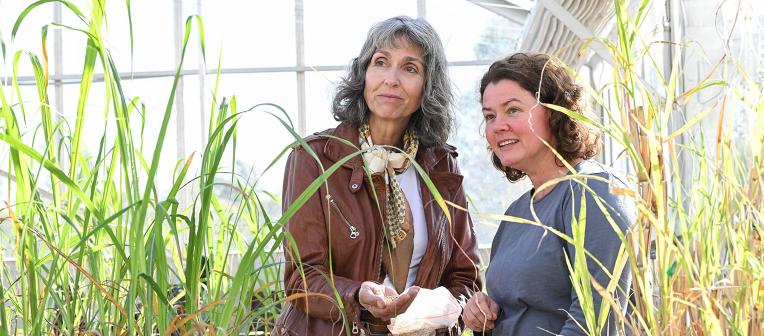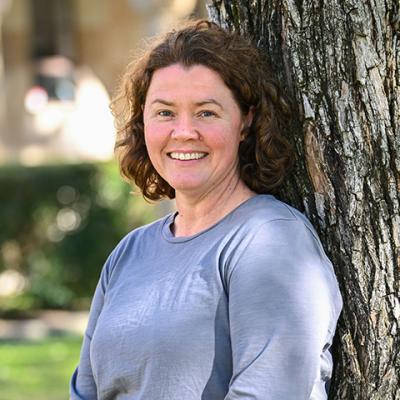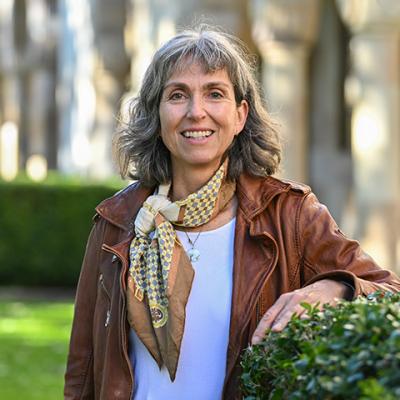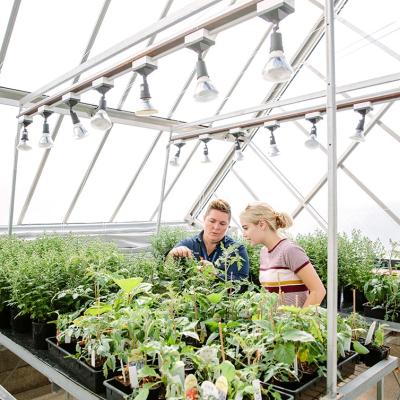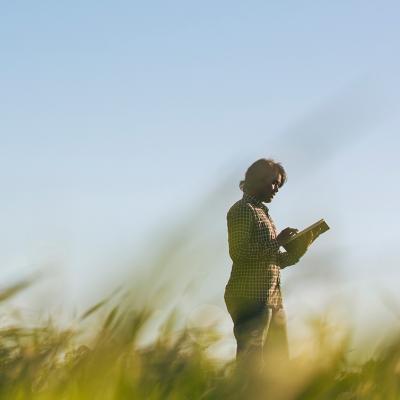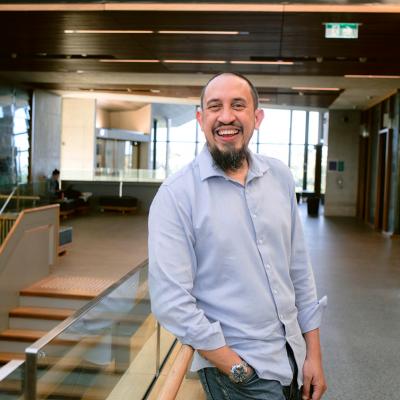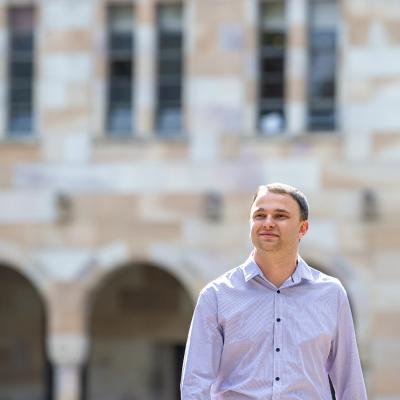Two UQ academics, Dr Nicole Robinson and Professor Susanne Schmidt, are fighting the good fight to protect our native soils from microplastics and keep our environment safe from fertiliser pollution – and their research could help the agriculture industry around the world.
There are two main types of fertilisers used in agriculture today. Unfortunately, both types pose threats to the environment.
The most common fertilisers dissolve too quickly in the soil and can therefore easily wash away, which pollutes waterways and marine ecosystems. Other types of fertiliser are better retained in soil, but their plastic coatings cause microplastic pollution.
The good news is Nicole (a UQ Research Fellow) and Susanne (a Professor in the UQ School of Agriculture and Food Sustainability) are on the case and developing solutions.
What problems do current fertilisers cause for soil health?
Fertilisers have a crucial role to play in providing nutrients to crops, but they can have harmful side effects on the environment.
“Fertilisers are like fossil fuels in that they provide an essential service that comes at a great cost,” says Susanne.
Fertilisers are also like fossil fuels in the sense that they are based on old technology compared to technology in other fields such as renewable energy or medicine.
“The most commonly used fertilisers are literally the same as 100 years ago,” she says.
“Imagine if medicine has not progressed since then: we would not have antibiotics and other modern medicines that save lives.”
“The nutrients in current fertilisers are often present in larger amounts than can be used by crops, and the excess nutrients can then be lost from the soil,” adds Nicole.
“As a result, fertilisers go on to pollute waterways and contribute to greenhouse gases emissions.”
For aquatic ecosystems (such as Queensland's Great Barrier Reef), this leads to unwanted nutrients, which cause a wide range of issues like:
- algal blooms that threaten fish
- crown-of-thorns starfish thriving and destroying coral
- oxygen-depleted ocean waters that are unable to sustain life.
There is a way to combat the fertiliser pollution problem of ‘too many nutrients at once’, but this creates a whole new dilemma.
“To slow down the release of nutrients to better match the growth of crops, various coatings have been added to the fertiliser granules,” says Nicole.
“Unfortunately, many of these current controlled-release fertilisers available to growers are coated with polyethylene, a plastic that stays in soil for hundreds of years.”
“These fertiliser coatings are a considerable contributor of microplastics in soil. They can disrupt soil organisms and negatively impact soil health and fertility. For example, earthworms suffer after ingesting microplastics, yet earthworms are essential for healthy soils. Because microplastics can end up in crops and our food, new materials are needed for next-generation fertilisers.”
What are microplastics?
Microplastics are the miniscule plastic particles that result from plastics degrading in nature. They have been discovered in several species of marine animals, as well as in some foods (like salt), drinking water, soil, and even the air. Ingesting or inhaling these microplastics can have harmful effects on humans and animals alike, which makes them a high-priority concern for public health and food safety.
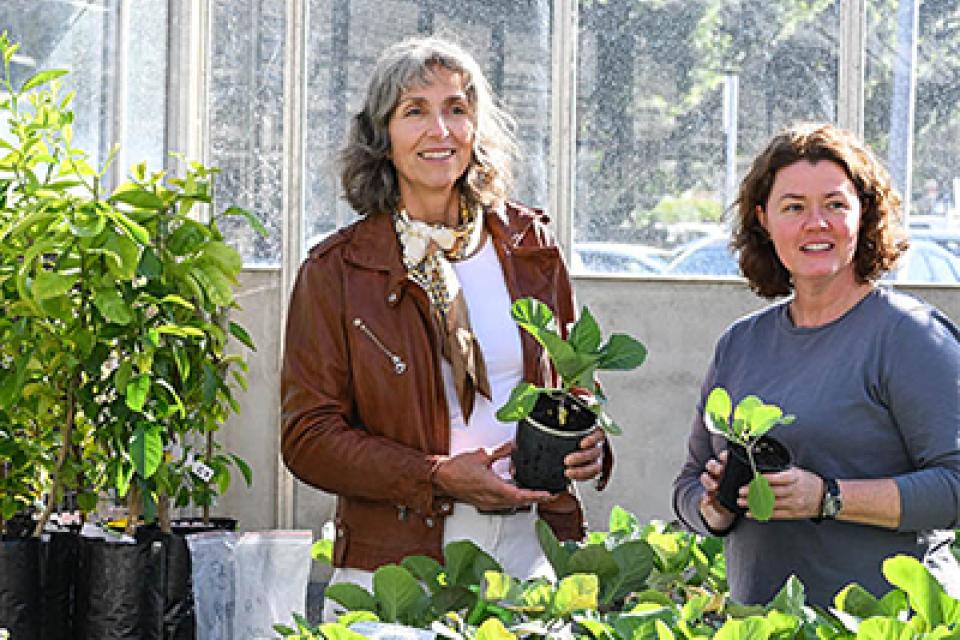
So, how do we reduce fertiliser pollution while ensuring sufficient food?
Luckily, Nicole and Susanne are already all over it, working with researchers from the School of Chemical Engineering to develop new types of bio-friendly fertiliser that don’t jeopardise soil.
“We first looked at the current knowledge and then brainstormed ideas,” says Susanne.
“The engineers came up with the idea of a novel matrix design that embeds fertiliser particles in biodegradable plastic – like chocolate chips in cookie dough.”
The final product is a fertiliser made with bioplastics rather than regular plastics.
“Among the benefits is that these bioplastics are produced from renewable resources and are bio-degradable by microorganisms occurring in soil, so they do not leave a microplastic footprint,” says Nicole.
Now that the team has developed the technology, the next step is testing the new fertilisers – and we mean extensive testing: in the laboratory, in the greenhouse, and in the field. It’s essential that the results produced in controlled conditions stack up when used with different crops exposed to contrasting environmental factors like temperature, soils, and water availability.
“The materials engineers also want to try coating fertilisers with biodegradable plastic to cut costs, which – as far as we know – no one in the world has managed to do so far, so it's a very exciting area of research,” says Susanne.
“This requires another type of equipment, which one of the engineering staff has recently built.”
“Ideally, we want to make fertilisers that can accommodate crops with different nutrient needs throughout the growing season – a lettuce will need a small amount of fertiliser over a few weeks while sugarcane requires a lot more fertiliser and over 6 months.”
The ultimate goal for Nicole and Susanne is wide-scale use of these new fertilisers across Queensland, Australia, and perhaps eventually the world.
“If we can get new fertilisers adopted, farming would greatly benefit, because efficiency will increase: more fertiliser will go into crops and less pollution will threaten our environment,” says Susanne.
“It certainly will help our global family, as we need to achieve sustainable ways to grow food while keeping the planet healthy.”

What led Susanne and Nicole here?
Susanne was both motivated and interested in this study area from a young age.
“I grew up in Europe where my parents went hungry during the war, so food was always a big topic in our house, which meant that I became interested in agriculture,” she says.
“I spent much time in forests and fields, which made me happy, and I discovered interesting things like wild food plants.”
Teaching also seemed like a fun profession to Susanne. So, completing a science degree followed by a doctorate on Australian native ecosystems was the perfect way to merge her interests – and this naturally led to becoming a professor.
The passion was sparked a little later for Nicole, who first studied plant science, marine science and ecology during her Bachelor of Science at UQ.
“It wasn’t until I started my undergraduate degree with my first-year subjects that I realised how interested I was in how plants worked,” she says.
“I particularly enjoyed how I could explore the topic at different scales: from a molecular level up to the individual plant, to crops and the ecosystem level, and then even to a global scale with the nitrogen cycle.”
“I enjoy being able to work with researchers from different faculties as well as farmers and producers to combine our different perspectives and viewpoints. I am motivated by the applied aspect of our research to be able to contribute to solutions for societal and environmental problems.”
This experience, along with her newfound fascination, led Nicole to complete an honours project in nutrient relations in algae, followed by a PhD studying nitrogen physiology in rainforest plants.

Studying agricultural science at UQ
Would you love to make game-changing impacts on the agricultural industry like Nicole and Susanne? UQ is quite possibly the best place to do so – and they both think so too.
“In my view, UQ offers amazing opportunities because there are so many interesting courses on offer, and they are taught by experts who are not only teachers but also researchers,” says Susanne.
“This means that students are exposed to the cutting edge of agriculture and innovation, to be well prepared for a future career.”
She also points out that UQ is the top university in Australia for agriculture and internationally recognised as a leading university in agriculture and environmental sciences.
“This means students get a quality education and have many choices to specialise within their bachelor’s degree, and they can potentially add an honours year or postgraduate degree,” she says.
“Tertiary studies are certainly a great way to explore ideas, deepen knowledge and skills, travel the world, and lead a meaningful life by contributing to society.”
Susanne also believes we have the golden combination of quality and diversity of researchers here.
“Just in the plant sector, we have around 250 researchers who study plants, from rare trees in rainforests to drought-resistant crops,” she says.
“This means endless opportunity to learn from experts in professional settings, often with industry, government and international connections.”
The diversity of people and study areas at UQ also enables unique collaborations for agricultural science students. In Susanne’s experience alone, this can include working with:
- engineers, who are the experts for biodegradable plastics and other new and eco-friendly materials
- economists, who calculate the costs and benefits for farmers and society to support the required change to sustainable practices
- social scientists and science communicators, who can ensure that new technologies are adopted
- Indigenous researchers, who can ensure the valuable knowledge of Australia’s First Nations peoples informs agriculture, including using the many native plants that are delicious and healthy, and advance the Indigenous economy and diversity of Australia’s agriculture.
Agricultural science students at UQ also enjoy access to state-of-the-art equipment, such as powerful microscopes, DNA sequencing facilities, and the 1,000-hectare Gatton Farms, which offer unique hands-on experience.

Nicole believes UQ science graduates like herself graduate with much more than the scientific skills to complete research.
“It is not only the knowledge framework and technical skills provided, but also the development of problem-solving, collaboration and communication skills,” she says.
“There’s also the opportunity to be involved in current research through various avenues such as practicals in our courses and subjects offering research projects.”
“These skills and research experience have been essential for undertaking our interdisciplinary research to develop novel fertiliser.”

Nicole and Susanne’s advice for students thinking about studying agricultural science at UQ
Nicole: “I would recommend trying out different subjects or areas of research that you previously had not considered. Also, look for opportunities to be involved with projects, clubs and practical experiences, as this will give you an idea of what you enjoy and the broad range of career pathways available to you.”
Susanne: “Follow your passion. I don’t think it matters if you only have a vague idea, because the little light in everyone can grow into a big flame. Don’t be shy, talk to the lecturers, ask for opportunities to volunteer, apply for awards and travel scholarships, and get involved early on. And enjoy getting to know your fellow students – some of them will become lifelong friends, and they will make an awesome contribution to your undergraduate years.”
Want to see how you could create change in the agriculture industry?

